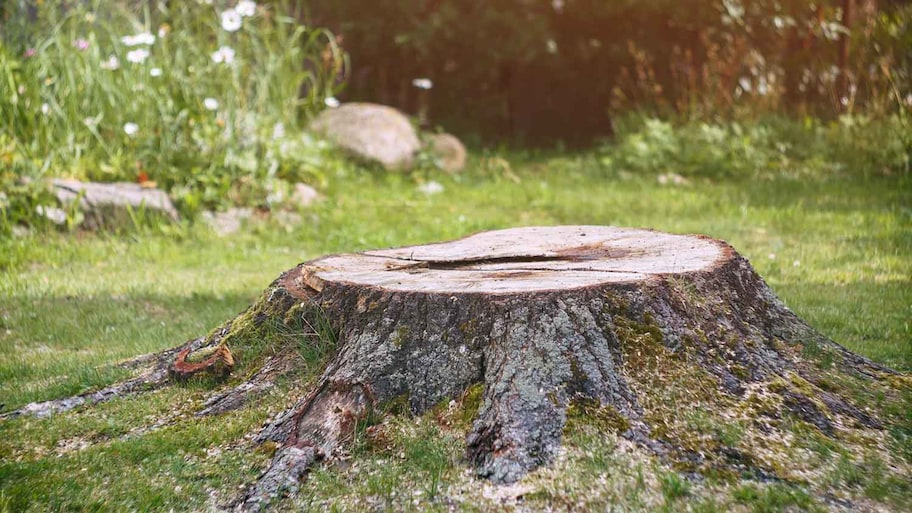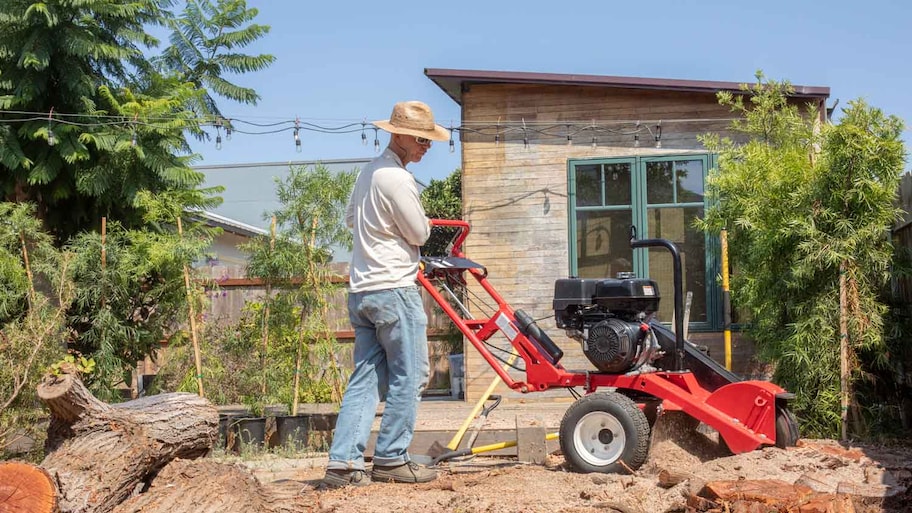How Much Does Stump Grinding Cost? [2024 Data]
Normal range: $120 - $400
The cost for stump grinding ranges from $30 to $1,600, but most homeowners will pay about $250. Hardwoods can make the task more expensive; you might also need to factor in debris removal and permits.


While the tree stump in your front yard makes for a nice place to sit, it may be posing a risk to the rest of the house. The typical stump grinding costs about $250. Whether a stump is imposing on your lush grass, creating a pest hazard, or needing to use the space for another home project, stump grinding is a quick and efficient way to remove the rest of the tree’s trunk without breaking the bank.
- Average
- $250
- Low end
- $30
- high end
- $1,600
Stump Grinding Cost Calculator
Calculations are based on the average diameter of a tree stump, which is about 25 inches. Calculations rounded to the nearest whole number.
| Quantity | Cost Range | |
|---|---|---|
| Stump Grinding | 25 inches in diameter | $50–$125 |
| Debris Removal | Debris from 1 tree stump | $50–$200 |
| Stump Removal Permit | 1 permit | $100–$500 |
| Optional: Root Removal | 2 hours of professional labor | $200–$400 |
| Total | $200–$825 | |
| Total per Inches in Diameter | $8–$33 | |
| Total with Options | $400–$1,225 | |
| Total per Inches in Diameter with Options | $16–$49 |
Stump Grinding Cost Factors
Stump grinding costs around $320 for most homeowners. You could pay as low as $150 for small stumps or as high as $500 for hardwoods or twisted trunks. On average, you can expect to pay from $2 to $5 per diameter inch to remove a tree stump, making larger stumps more costly to remove.
Stump grinding is a straightforward process involving three main factors: the cost to grind the stump, the permits needed to remove it, and the cost to put sod over the remaining pieces. Here’s a breakdown of tree stump grinding costs.
Size/Diameter
Stump grinding rates vary with the circumference of the tree trunk (how big around the tree stump is). These measurements use diameter inches rather than square feet or linear inches. On average, stump grinding prices sit between $2 and $5 per diameter inch. While your stump may be small in circumference, most contractors will charge a minimum fee of $100 for grinding services.
Number of Stumps
The number of stumps impacts how much you'll pay for stump grinding. Sure, the overall project costs more if you have multiple stumps removed, but the cost per stump can drop dramatically. Contractors usually have a minimum callout fee for a single stump, usually between $100 and $150. But additional stumps are often priced much lower, at about $40 to $75 each.
Tree Type

The tree species can have a surprising impact on the stump-grinding costs, especially if it’s harder to remove than other trees. Landscaping professionals aren’t likely to have a cost factor for every tree species. Instead, you’ll usually end up paying between $50 to $200 for extra labor in cases like these:
Hardwoods: Denser, harder wood compositions take more time to grind down, increasing labor while adding wear and tear on equipment. For example, elms, walnuts, certain oaks, and maples may take longer.
Twisted trunks: A very twisted, knotty trunk is likely to take longer to grind down, creating trickier positioning problems (especially for larger trees). These twisty tree species can include Jack and Scotch Pines, acacia varieties, Cork Oak, myrtle, and some willows.
Multiple trunks: In some species, a single tree can create a mass of multiple trunks, including Flame Maple, acacia trees, White Birch and other birches, dogwood trees, and fruit trees like the Japanese Crabapple or Tibetan Cherry.
Far-reaching roots: Broad or invasive root systems also prove difficult to remove if this is part of the grinding process. These include willows, sycamores, mulberry trees, cottonwoods, elms, and others.
Stump Health
The age and condition of your stump may prove important to the project budget. Older, rotten stumps with aged wood are typically far easier to remove with grinding, so labor costs are often lower.
Keep in mind that a diseased stump can still spread disease to other trees, so it’s important to get a stump with rot, blights, and other problems removed quickly. On the other hand, it’s also important to remove a healthy new stump fast because many common tree species will start sending out new shoots unless the trunk and roots are gone.
Stump Grinding Time
Larger stumps and denser woods will simply take longer to grind. That extra time directly affects how much labor is required, which can raise your costs. A simple stump grinding job may take only an hour. A difficult grinding project, with a very dense wood or complicated trunk growth, could easily take two or three hours, and labor costs will grow accordingly.
Accessibility and Terrain
If the tree stumps are on challenging terrain, access is limited, or the stumps are located a long way from where the contractor can park, expect to incur additional fees. Some pros add $50 per hour for the extra labor, while others include a flat fee of up to $200 for a challenging project.
Time of Year
Winter is typically the cheapest time of year for tree removal—and that includes getting rid of the stump. You can save as much as 20% by tackling this project during the coldest months when tree services have the least demand. Keep in mind that the cost to remove a stump completely is slightly more than the cost to grind a stump down.
Debris Removal
Expect to pay $50 to $200 for hauling away the waste from the stump grinding. You can save by removing the debris yourself, but if you can't haul it or have no use for it, let the contractor take care of it. They may charge you a rate of $50 per hour or give you a flat fee for debris removal based on the diameter of the stump. This process usually costs $2 to $4 per diameter inch.
Permits
You’re likely going to need permits to remove the stump. The reason being is there could be utility lines underneath the stump that require extra safety measures to ensure they aren’t hit. Permits cost around $100 to $500, depending on your city.
It’s not as common, but certain types of stump grinding may require an additional permit beyond those required to dig near utility lines. If you’re removing a tree entirely, you should check that the species doesn’t have legal protections in your region. Likewise, you may not be able to remove some trees because of laws regarding a certain amount of trees in a plot. On that note, if you are a part of a homeowners association, you should look up the bylaws on tree removal to ensure you don’t accidentally violate any rules or regulations.
Additional Stump Grinding Project Costs
Don’t forget to account for these additional expenses when planning your stump grinding project.
Sodding
Once the tree is gone, you’ll want to sod the ground where the stump was. If not, it may leave an unsightly dead patch of grass behind. Sod installation costs around $1 to $2 per square foot for labor and materials. Mulching is another option that’s a bit more affordable at $0.35 per square foot, on average.
Root Removal
To remove the roots and grind away the stump, expect to pay between $100 and $200 per hour. While removing the roots after stump grinding isn't essential, it's necessary if you want to make substantial use of the area.
For example, if you want to turn the area into a vegetable garden, having an extensive root network below the surface makes digging really tough. Eventually, the roots will decay, leaving a void in the earth. So if you want to build a structure over the area, your structure could face significant structural damage that costs thousands of dollars to fix.
Tree Removal
Tree removal costs between $200 and $2,000 per tree. The price includes felling the tree, cutting it into manageable pieces, and hauling it away. It usually doesn't include stump grinding or root removal. However, for smaller trees, the arborist may be able to dig up the entire tree, roots and all.
Tree Transplanting
Transplanting a tree costs $800 on average, but it can cost upwards of $1,500 to transplant a large tree in the same yard. During your stump removal, you may want to transplant a tree into the area where the stump once was. It’s a common way to switch up your landscaping and save on the cost of a totally new tree.
Tree Trimming
For most homeowners, tree trimming costs anywhere from $75 to $1,800—with small trees on the low end and very large trees on the high end. Since stump grinding is a relatively small job, you can sometimes save money on the cost of a tree service by tacking on extra jobs like tree trimming.
How Much Does Stump Grinding Cost to Do Yourself?

If you remove a stump on your own, you won’t have to pay for the cost of labor. You’ll only have to pay for equipment rentals (mainly, a stump grinder to grind down the stump). Luckily, there are a few different stump removal methods that don’t involve grinding. You can avoid these rental costs by using tools that you probably already have in your shed—like a chainsaw, ax, mattock, and shovel.
Cost to Rent a Stump Grinder
If you’re used to heavy machinery and feel confident in your abilities, you can rent a stump grinder for around $190 to $270 per day. Since grinding takes about a day, you can usually pick up the grinder first thing in the morning and return it by the evening. That way, you only pay for one day of renting.
However, because of the cost of renting the equipment, you may not save any money over hiring a pro. Plus, stump grinding is a risky business with plenty of potential for injury.
DIY vs. Hiring a Pro
If your tree stump is near a utility line or close to your home, leave this job to a pro. When you hire a local stump remover, they’ll know the codes ahead of time. That way, you don’t need to worry about the legality of the stump removal process.
You can reduce your spending by tackling the preparation and cleanup yourself. This includes tasks like clearing debris from the area before the work begins and using or hauling away the waste after the stump grinding. Replant, lay sod, and otherwise reinvigorate the site once the stump is gone yourself to save money and improve the look of your yard.
Stump Grinding vs. Removal
Tree stump removal and stump grinding are often used interchangeably by the general public, but they’re not the same thing. It can get confusing because, technically, grinding removes the stump—or at least grinds it down enough that it’s effectively removed. The roots are left intact to deteriorate over time.
With true stump removal, your contractor will remove the entirety of the stump, including the roots. Stump grinding is typically more manageable and takes less time.
Tree stump removal costs $100 to $200 more than stump grinding. Where possible, although it's a little more costly, have the stump removed fully rather than just ground down. Only opt for stump grinding when it's not practical to remove the whole stump.
Leaving roots untouched can ruin your pavers, damage your home's foundation, and destroy your lawn. Fully removing the stump lets you make proper use of the space, whether you're planning to build on it or just plant a garden.
How to Save on Stump Grinding Costs
If the costs of professional stump removal are steep, you can try several tactics to help find the lowest price possible.
Get several estimates: Stump grinding costs can vary across service companies. Learn about the expected costs in your area by getting different quotes from three local services. When possible, get an in-person estimate from a professional who can view the physical stump and its location.
Make stump access and removal easier: Clear undergrowth and pathways to your stump. The faster professionals can gain access and grind away, the easier the task will be. Saving time for your contractor can save you money.
Bundle tree needs: Hire one company to take care of several tree-related tasks—that can include tree removal, grinding, root removal, planting new trees, and more. It may take companies several days, but the overall costs should be lower when you bundle everything together in one package.
Take care of clean-up: Agree to take care of cleanup yourself to save on labor costs. Make a plan to remove wood chips and use them as mulch, or pack them into the leftover hole.
Grind down to surface level only: Standard stump grinding typically goes past the surface to remove the core clump of roots. This method creates a well-like depression that’s filled in for future landscaping, but it’s not always necessary. There are also options for surface-level grinding that only grinds down to the level of the soil. Surface-level grinding works well with a stump that’s long dead or unlikely to send up new shoots, and the costs are lower for this service.
Frequently Asked Questions
Grinding down a tree helps reduce the risk of foundation damage and pests and even helps your home’s curb appeal. Stumps can also be a safety hazard. If grass grows above the stump and someone else mows your yard, they may be in for a rude awakening when they accidentally hit the stump.
Tree removal costs typically don’t include stump removal, as that technically falls into a different service. The company you hire may offer the service for an additional cost; ask them if they offer it to ensure you’re getting the best tree stump removal costs possible.
A standard tree removal doesn’t include stump grinding. If you want your contractor to remove your tree and grind the stump, you’ll have to pay an extra charge. That said, you’ll likely save on the cost of stand-alone service—especially if it’s a small tree and they can finish both jobs in a single trip.
The most common alternative is burning the stump first, then dealing with the cinders and ashes. As you can imagine, this option creates fire hazards, especially since roots can burn underground, hidden, for long afterward. That’s why many states and cities have outlawed the use of stump burning entirely. We do not recommend this option as a viable alternative unless you get a permit from the local fire department and practice all safe-burning procedures.
If your stump has a pest problem, don’t worry, it won’t slow down the stump grinding process at all. In fact, it might even speed it up. But you may want to contact pest control afterward if it looks like an infestation that’s spreading.

